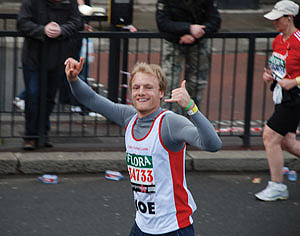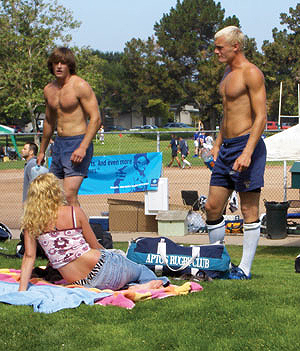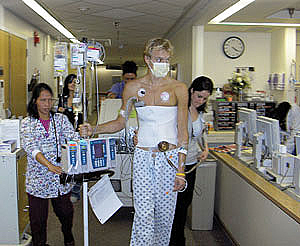July 15, 2009 - By Tracie White
How Stanford Hospital & Clinics gave a British teenager, ‘English Joe,’ a transplant — and a new life

Joseph Matthews, who is known as “English Joe,” manages to complete a marathon in London on April 13, 2008. The problem, he says, was a sprained ankle, not his transplanted heart, caused by a collision at the 7-mile point.
Joe Matthews’ heart stopped beating on its own for nearly an hour in March 2006 at Stanford Hospital where he was undergoing a procedure to implant a heart defibrillator. But this was one cocky rugby player who had no intention of getting kicked out of the game just yet.
Within the span of a few weeks, Matthews, who calls himself “English Joe,” had gone from days spent playing rugby and surfing in the Aptos, Calif., beaches to fighting for his life in a hospital bed. The 18-year-old’s once strong heart had suddenly become so weak and flabby that it couldn’t withstand the shock of the defibrillator and simply stopped pumping altogether.
And nobody has a clue as to why.
“It went into cardiac arrest,” Matthews said during an Internet/phone interview from his hometown of Lowestoft, England. “My heart just stopped.”
If Matthews had the procedure elsewhere—in fact, he had just been transferred from another facility—the doctors might not have had the resources and expertise that are available at Stanford Hospital & Clinics to respond to such an emergency. For almost an hour, medical personnel kept him alive by pumping on his chest while they transferred his body onto a stretcher and rushed him from the cath lab to the operating room. He then had a 10-hour emergency open-heart surgery to install a left ventricular assist device, or LVAD, to get his heart pumping again. Three weeks later, he’d undergo a heart transplant.
That was three years ago. Today, Matthews is back in England training for the World Transplant Games to be held in Brisbane, Australia, in August. Since his heart transplant, he’s replaced his passion for rugby with track and field and hopes to set a new world’s record in the 100 meters at the Transplant Games. His personal best time to date is 10.9 seconds.
Attempts to unravel the mystery of Matthews’ particular type of heart failure continue at Stanford, a leader in the field of heart and lung transplantation since the late Norman Shumway, MD, PhD, professor emeritus of cardiothoracic surgery, performed the first successful U.S. human heart transplant in 1968 at Stanford.

Joe Matthews appears to be in excellent physical condition, as he waits to begin play in a rugby game only a few weeks before March 2006 when he would find himself in Stanford Hospital suffering from cardiac arrest.
“This place has a long and important history in the area of heart failure,” said Robert Robbins, MD, chair of cardiothoracic surgery and director of the Stanford Cardiovascular Institute, who last week briefed U.S. senators on advances in the field. “We expect to make important advances in the future, as well, in better understanding the mechanisms of heart failure.”
Heart failure typically occurs in the elderly, patients diagnosed with coronary artery disease, with diabetes or uncontrolled high blood pressure. But Matthews fit into a whole other category. He was diagnosed with idiopathic cardiomyopathy, or heart failure of mysterious origins—a disease that causes the deterioration of the heart muscle.
About half of all heart transplant operations are done on patients like Matthews. Idiopathic cardiomyopathy strikes young children, seniors, athletes alike. Solving the mystery of its causes has become a particular passion of Robbins. “Here’s this 18-year-old strapping, good-looking guy,” said Robbins who got a call in his office to perform the emergency operation the day Matthews’ heart stopped. “An exercise freak, who didn’t smoke—fit as anything. And yet I could barely get both my hands around his heart. It was about the size of a volleyball. And it barely moved. They rushed him down the hall, we put an artificial pump in him; we saved him, and later transplanted him. Since then he’s run two marathons.

Matthews lived for three weeks with tubes coming out of his body, a result of the left ventricular assist device that was installed in his chest during a 10-hour emergency surgery to keep his heart beating.
“So that’s a great story. But the real story is, ‘Why did his heart fail?’ His heart muscle looked normal, it just didn’t work. We have no idea what causes it. Our job is to put this kind of heart surgery out of business.”
As part of this mission, Robbins has recruited Euan Ashley, MD, PhD, a genetics researcher and member of the cardiovascular institute’s heart failure/transplant group, to research possible genetic causes of idiopathic cardiomyopathy. Ashley’s group has set up a large tissue bank of diseased heart muscle samples, which includes a sliver of Matthews’ heart, for conducting genetics-based studies.
Meanwhile, Matthews continues to run road races, half marathons and marathons to raise money for cardiomyopathy research. He’s set up a Web site, englishjoe.net, to provide resources for people like himself who suddenly find themselves in a hospital bed facing a heart transplant. It can take time to get over the shock, but look how great it can turn out, he said. “I was brought up to deal with whatever was placed in front of me,” Matthews said. “I figured I could either moan about it and be scared or I could deal with it.”
But even Matthews admits he freaked out immediately after his near-death experience. He woke up from what he thought was a minor procedure, to find two pumps stuck through his stomach feeding his body blood, and facing the news he needed a new heart, fast. When he couldn’t sit up, he tried to yank the pumps out of his stomach until the nurses had to strap him down to the hospital bed.
“I laughed when they asked my permission to have a heart transplant,” he said. “I figured I had two choices: a heart transplant and live, or no heart transplant and die. I took the live option.”
About Stanford Medicine
Stanford Medicine is an integrated academic health system comprising the Stanford School of Medicine and adult and pediatric health care delivery systems. Together, they harness the full potential of biomedicine through collaborative research, education and clinical care for patients. For more information, please visit med.stanford.edu.